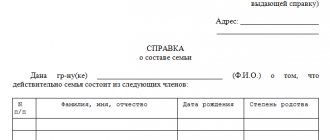What is a “Homeowners Absentee Voting Ballot”?
The decision form of the owner of the premises in the apartment building or the bulletin is a form of participation in the life of the house. According to Part 1 of Article 44 of the Housing Code, the general meeting of owners is considered to be the governing body of the house. All issues of content and management are decided by voting.
It is the ballot papers with the corresponding voting agenda items and answers to each issue in the form of “for”, “against”, “abstained” that are the basis for making a decision.
Sample protocol for absentee voting of homeowners
Nuances
When conducting in-person and absentee voting, the results must be documented in a single protocol, taking into account all votes. All decisions and minutes of the meeting are recognized as legal documents. Based on them, the owners of premises in an apartment building become obligated to implement the decisions made.
The decisions and voting protocol are transferred by the initiator of the meeting to the management company within ten days from the date of the event (Part 1 of Article 46 of the Housing Code). They are placed in the unified information system GIS housing and communal services. The originals are transferred within five days to the State Housing Inspectorate for storage and must be stored for three years.
Falsifying a residents' voting protocol entails criminal penalties in the form of one of the following:
- restrictions of freedom for up to 2 years;
- forced labor for up to 2 years;
- arrest for up to six months;
- imprisonment for up to 2 years.
FacebookVKontakte
Content
The information that must be indicated in the document is determined by clause 5.1 of Article 48 of the Housing Code:
- information about the owner of the premises - the voting participant (for a citizen, the full name must be filled in; for an organization, its name must be filled in);
- details of the document confirming the voter’s ownership of the premises in the house;
- all issues put to vote on the agenda and the decision on each of them are written down.
The document contains the date of completion and the personal signature of the person who voted. Additionally, the final date and address for receiving ballots are indicated in the form of a memo.
Protocol form
The legislation does not establish a strict form for the absentee voting protocol. It can be developed by the management company and enshrined in local regulations. For legal recognition of a document, it must contain the mandatory details specified in paragraph 5 of Art. 181.2 of the Civil Code.
Protocol form for absentee voting of homeowners
How to correctly fill out the absentee voting ballot for homeowners?
When preparing the bulletin, you should take into account the explanations of the Ministry of Construction given in letter dated 10/05/2017 No. 35851-EC/04:
- The decision will be considered valid if the owner of the premises in the house who voted on the ballot can be accurately identified.
- In case of an error or typo, it is allowed to make a correction, but it must be certified with the appropriate entry and the personal signature of the owner. According to the rules of office work, the entry looks like “corrected believe.”
- The date and personal signature of the person who voted is considered proof that the decision has been made at this time. If there is no signature, the document is considered invalid.
- The decision on each item on the agenda must be expressed unambiguously. A mark is placed in only one of the points “for”, “against” or “abstain”. If there is no mark or if they are marked in several points on this issue, the participant’s vote will not be taken into account. The decision will be made based on the results of counting the votes of the remaining owners who filled out the ballots correctly.
- The owner’s decision on the entire agenda of the meeting is canceled if his opinion on each issue is not clear.
On the transfer to the State Housing Registration Authority
Clause 4 of the Procedure clarifies that copies of documents are considered transferred if the manager of the MKD has a document confirming the fact and date of their transfer to the State Housing Authority. The most obvious way is transfer by courier, with receipt of a receipt from the employees of the State Housing Registration Authority indicating the date of transfer of documents. Please note: the Order does not say that this is the only possible method. For managers in settlements located at a significant distance from the regional center, where the State Housing Authority is usually located, this option may be very inconvenient. Considering the equality of rights of all business entities, it seems fair that managers can send a package of documents to officials by registered mail with an inventory of the contents and a return receipt.
What is it and why is it needed?
Voting by members of the partnership is a way to clarify all issues that are within the competence of the general meeting.
According to the norms of housing legislation, the procedure can be in person or in absentia .
At the same time, the correspondence form is most often used if there are a lot of members of the organization, so it is impossible to collect them all.
In addition, this procedure allows you to get as many votes as possible from those owners who often miss meetings .
Sample absentee voting ballot for HOA.
Sample minutes of the general meeting of the HOA in the form of absentee voting.
State Housing and Construction Supervision Service of the Irkutsk Region
21.03.2016
Types of ownership of real estate
Before proceeding to counting votes at the OSS, it is necessary to determine the types of ownership of premises in the apartment building. Since the correct counting of votes at the general meeting depends on the type of ownership of real estate.
For example, if there is not one, but several owners in an apartment, then each of them will have the right to vote in proportion to the share in the common property right. Therefore, if from some apartment only one owner out of two or three shareholders was present at the OSS, then his vote cannot be counted for all the owners of this apartment if he does not have a power of attorney from these owners. Because of this, often if votes are counted incorrectly, a quorum may or may not be reached, which can subsequently be challenged in court. In this case, the meeting will be declared invalid.
Real estate can belong to owners on the basis of joint and common shared ownership .
According to Article 244 of the Civil Code of the Russian Federation, property owned by two or more persons belongs to them under the right of common ownership. Common ownership of property is recognized as shared ownership, unless the law provides for the formation of joint ownership of this property.
In accordance with clause 1 of Article 245 of the Civil Code of the Russian Federation, the shares of participants in the right of common ownership of real estate can be determined by their agreement or on the basis of law. If the size of the shares cannot be determined by the listed methods, then they are recognized as equal.
It is interesting that the Civil Code of the Russian Federation does not specify in what terms the size of shares in the right of common ownership of real estate is determined. However, from the precedents of law enforcement practice, a point of view emerges that allows the shares of participants in common shared ownership of real estate to be expressed both in fractions and as percentages (Resolution of the Federal Antimonopoly Service of the Moscow District dated 03/07/2003 No. KG-A40/944-03).
A similar judgment is contained in clause 5.18 of the Procedure for filling out the form “Information on the inventory value of real estate and other information necessary for calculating taxes” (Order of the Federal Tax Service dated February 11, 2011 No. ММВ-7-11 / [email protected] ).
The right of ownership and other real rights to real estate (restriction, emergence, transition and termination) are subject to state registration in the Unified State Register of Authorities by the bodies that carry out state registration of rights to real estate and transactions with it (Article 131 of the Civil Code of the Russian Federation).
In accordance with the Rules for maintaining the Unified State Register, the size of the share in the right of common ownership must be indicated (Order of the Ministry of Economic Development No. 765 of December 23, 2003). This rule specifies the indication of the size of the share in the form of a regular simple fraction.
Based on this rule, some courts overturn decisions of lower judicial bodies, in which the size of the share in the right to real estate is indicated as a percentage (resolution of the Fourth Arbitration Court of Appeal dated September 16, 2011 No. 04AP-3334/07).
As can be seen from the examples above, indicating in the contract the size of the share in the right of common ownership in the form of interest sometimes leads to legal disputes. Therefore, it is more expedient to indicate in the exchange agreement the size of the shares of participants in common shared ownership in the form of proper fractions.
There is also joint common ownership in the right of common ownership of real estate, when several people together and at their own discretion can use and dispose of the property that belongs to them on a trust basis. As a rule, joint ownership of real estate arises among spouses (Article 256 of the Civil Code of the Russian Federation) if it was acquired during marriage.
There is another option for joint ownership of real estate, which arises when living space is privatized by people living together, regardless of their family ties. The privatization agreement form contains a column that allows owners to determine what kind of ownership they want to transfer their property into: joint or shared.
How to count the votes of owners on the OSS
The counting of votes of owners at the OSS, as we wrote above, depends on the type of ownership of real estate. Let's consider the counting of votes at a general meeting when voting among participants in common joint and shared ownership.
Counting votes at OSS under common joint ownership
Participants in common joint ownership , unless otherwise provided by an agreement between them, jointly own and use common property (Part 1, 2, Article 253 of the Civil Code of the Russian Federation). Any of the owners can dispose of joint property with the consent of the others, regardless of which of the participants makes the transaction.
The courts believe that when counting votes at the OSS, the votes of all participants in the common joint property (by agreement between them) must be taken into account if at least one of them took part in the general meeting. Thus, one owner, on the right of common joint ownership, acts with the consent of all its participants. Therefore, his vote will be considered as 100% presence of the owners of a certain residential premises in the apartment building.
There is an excerpt from the Appeal ruling of the Samara Regional Court dated 04/11/2013 in case No. 33-3425/2013: “If the premises are in common joint ownership without determining the shares of several persons, then by agreement between them their interests are represented on the basis of a duly executed power of attorney one of the owners, who signs the voting ballot (sheet), or each owner.”
But if there is no agreement between the owners on the right of common joint ownership of real estate on the joint use and disposal of property or a properly executed power of attorney, then the vote of one owner cannot be counted in making a decision based on the entire area of the apartment.
There is an excerpt from the ruling of the Moscow Regional Court dated January 12, 2012 in case No. 33-566/2012 (33-29450/2011: “From the case materials, it is clear that apartments: N are joint property, and one of the owners of these took part in the voting residential premises, despite this, his vote was counted based on the entire area of the apartment. Meanwhile, the voting persons did not have agreements, agreements and contracts with each other on the management of common property, provided for in the provisions and Articles 244-247 of the Civil Code of the Russian Federation, as well as those who voted the apartment owners did not have powers of attorney from other owners, and therefore, according to the well-founded conclusions of the court, the votes participating in the voting were less than 50%.
Counting votes at OSS with common shared ownership
When counting the votes of participants in common shared ownership, the number of votes of these owners must correspond to their shares in the right to living space. For example, the living space is 45 sq.m. and only one of the owners with a ⅓ share of this premises in the apartment building voted on the OSS. Then this owner has only 15 votes, which must be taken into account when counting the votes.
For example, the Saratov Regional Court, in its appeal ruling dated July 27, 2012 No. 33-3710, came to the conclusion that due to the lack of a quorum, the OSS was declared invalid for choosing a method of managing an apartment building. The court also referred to the fact that some voting participants are the owners of only 1/2 shares in the right of common shared ownership of living space in the house. But, as it turned out, when counting votes at the OSS, their votes were counted without taking into account shared ownership. This is not legitimate and is incorrect.
Another judicial precedent established that when counting votes at the OSS of the owners of several residential premises, their votes were taken into account as the sole owners of residential premises in the house . But according to Rosreestr, these apartments were in common shared ownership. At the same time, the remaining participants in the common shared ownership in the specified residential premises did not take part in the voting.
Based on the foregoing, the court came to the conclusion that the votes of these persons when calculating the results of the OSS voting should have been taken into account in proportion to the shares of the voting owners in the right of common shared ownership of the living space (appeal ruling of the Murmansk Regional Court dated August 15, 2012 in case No. 33-2032).
Summary
Therefore, it is very important to correctly count the votes of the results of the general meeting of owners . The presence of a quorum at the meeting or its absence directly depends on this. Consequently, the outcome of the general meeting of owners also depends.
That is why we recommend that management organizations check documents confirming the ownership of real estate before the general meeting and enter this data into the register of OSS participants. Then you will know exactly what percentage of votes to take into account based on the area of a particular room. And there will be no claims against you from the owners or regulatory authorities. The meeting and the decisions made at it will be absolutely legitimate.








